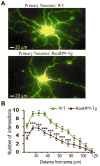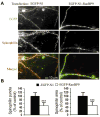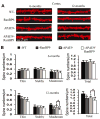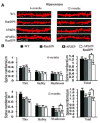RanBP9 overexpression accelerates loss of dendritic spines in a mouse model of Alzheimer's disease
- PMID: 24892886
- PMCID: PMC4113832
- DOI: 10.1016/j.nbd.2014.05.029
RanBP9 overexpression accelerates loss of dendritic spines in a mouse model of Alzheimer's disease
Abstract
We previously demonstrated that RanBP9 overexpression increased Aβ generation and amyloid plaque burden, subsequently leading to robust reductions in the levels of several synaptic proteins as well as deficits in the learning and memory skills in a mouse model of Alzheimer's disease (AD). In the present study, we found striking reduction of spinophilin-immunoreactive puncta (52%, p<0.001) and spinophilin area (62.5%, p<0.001) in the primary cortical neurons derived from RanBP9 transgenic mice (RanBP9-Tg) compared to wild-type (WT) neurons. Similar results were confirmed in WT cortical neurons transfected with EGFP-RanBP9. At 6-months of age, the total spine density in the cortex of RanBP9 single transgenic, APΔE9 double transgenic and APΔE9/RanBP9 triple transgenic mice was similar to WT mice. However, in the hippocampus the spine density was significantly reduced (27%, p<0.05) in the triple transgenic mice compared to WT mice due to reduced number of thin spines (33%, p<0.05) and mushroom spines (22%, p<0.05). This suggests that RanBP9 overexpression in the APΔE9 mice accelerates loss of spines and that the hippocampus is more vulnerable. At 12-months of age, the cortex showed significant reductions in total spine density in the RanBP9 (22%, p<0.05), APΔE9 (19%, p<0.05) and APΔE9/RanBP9 (33%, p<0.01) mice compared to WT controls due to reductions in mushroom and thin spines. Similarly, in the hippocampus the total spine density was reduced in the RanBP9 (23%, p<0.05), APΔE9 (26%, p<0.05) and APΔE9/RanBP9 (39%, p<0.01) mice due to reductions in thin and mushroom spines. Most importantly, RanBP9 overexpression in the APΔE9 mice further exacerbated the reductions in spine density in both the cortex (14%, p<0.05) and the hippocampus (16%, p<0.05). Because dendritic spines are considered physical traces of memory, loss of spines due to RanBP9 provided the physical basis for the learning and memory deficits. Since RanBP9 protein levels are increased in AD brains, RanBP9 might play a crucial role in the loss of spines and synapses in AD.
Keywords: APΔE9 mice; Cortex; Dendritic spines; Hippocampus; RanBP9; Transgenic mice.
Copyright © 2014 Elsevier Inc. All rights reserved.
Conflict of interest statement
Figures








Similar articles
-
RanBP9 aggravates synaptic damage in the mouse brain and is inversely correlated to spinophilin levels in Alzheimer's brain synaptosomes.Cell Death Dis. 2013 Jun 13;4(6):e667. doi: 10.1038/cddis.2013.183. Cell Death Dis. 2013. PMID: 23764848 Free PMC article.
-
RanBP9 overexpression reduces dendritic arbor and spine density.Neuroscience. 2014 Apr 18;265:253-62. doi: 10.1016/j.neuroscience.2014.01.045. Epub 2014 Jan 31. Neuroscience. 2014. PMID: 24486966 Free PMC article.
-
RanBP9 overexpression down-regulates phospho-cofilin, causes early synaptic deficits and impaired learning, and accelerates accumulation of amyloid plaques in the mouse brain.J Alzheimers Dis. 2014;39(4):727-40. doi: 10.3233/JAD-131550. J Alzheimers Dis. 2014. PMID: 24254706
-
Dendritic spine loss and synaptic alterations in Alzheimer's disease.Mol Neurobiol. 2008 Feb;37(1):73-82. doi: 10.1007/s12035-008-8018-z. Epub 2008 Apr 26. Mol Neurobiol. 2008. PMID: 18438727 Review.
-
Synapses and dendritic spines as pathogenic targets in Alzheimer's disease.Neural Plast. 2012;2012:247150. doi: 10.1155/2012/247150. Epub 2012 Feb 6. Neural Plast. 2012. PMID: 22474602 Free PMC article. Review.
Cited by
-
Transforming Growth Factor β1 Ameliorates Microglial Activation in Perioperative Neurocognitive Disorders.Neurochem Res. 2023 Dec;48(12):3512-3524. doi: 10.1007/s11064-023-03994-w. Epub 2023 Jul 20. Neurochem Res. 2023. PMID: 37470907
-
RANBP9 as potential therapeutic target in non-small cell lung cancer.J Cancer Metastasis Treat. 2020;6:18. doi: 10.20517/2394-4722.2020.32. Epub 2020 Jun 24. J Cancer Metastasis Treat. 2020. PMID: 34778565 Free PMC article.
-
Transgene Delivery to Human Induced Pluripotent Stem Cells Using Nanoparticles.Pharmaceuticals (Basel). 2021 Apr 6;14(4):334. doi: 10.3390/ph14040334. Pharmaceuticals (Basel). 2021. PMID: 33917388 Free PMC article. Review.
-
Single-microglia transcriptomic transition network-based prediction and real-world patient data validation identifies ketorolac as a repurposable drug for Alzheimer's disease.Alzheimers Dement. 2025 Jan;21(1):e14373. doi: 10.1002/alz.14373. Epub 2024 Dec 6. Alzheimers Dement. 2025. PMID: 39641322 Free PMC article.
-
The reduction of astrocytic tau prevents amyloid-β-induced synaptotoxicity.Brain Commun. 2022 Sep 19;4(5):fcac235. doi: 10.1093/braincomms/fcac235. eCollection 2022. Brain Commun. 2022. PMID: 36196088 Free PMC article.
References
-
- Alvarez VA, Sabatini BL. Anatomical and physiological plasticity of dendritic spines. Ann Rev Neurosci. 2007;30:79–97. - PubMed
-
- Battaglia F, Wang HY, Ghilardi MF, Gashi E, Quartarone A, Friedman E, et al. Cortical plasticity in Alzheimer's disease in humans and rodents. Biol Psychiatry. 2007;62:1405–1412. - PubMed
Publication types
MeSH terms
Substances
Grants and funding
LinkOut - more resources
Full Text Sources
Other Literature Sources
Medical
Molecular Biology Databases
Miscellaneous

